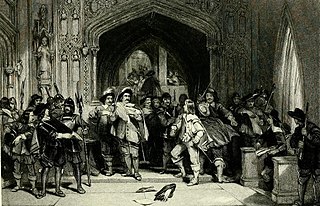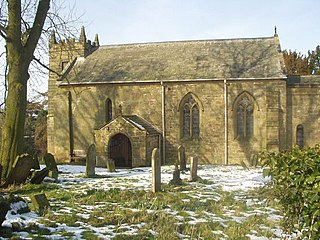
The Long Parliament was an English Parliament which lasted from 1640 until 1660. It followed the fiasco of the Short Parliament, which had convened for only three weeks during the spring of 1640 after an 11-year parliamentary absence. In September 1640, King Charles I issued writs summoning a parliament to convene on 3 November 1640. He intended it to pass financial bills, a step made necessary by the costs of the Bishops' Wars against Scotland. The Long Parliament received its name from the fact that, by Act of Parliament, it stipulated it could be dissolved only with agreement of the members; and those members did not agree to its dissolution until 16 March 1660, after the English Civil War and near the close of the Interregnum.

Major-General William Goffe, probably born between 1613 and 1618, died c. 1679/1680, was an English Parliamentarian soldier who served with the New Model Army during the Wars of the Three Kingdoms. A religious radical nicknamed “Praying William” by contemporaries, he approved the Execution of Charles I in January 1649, and later escaped prosecution as a regicide by fleeing to New England.

John Lambert was an English Parliamentarian general and politician. Widely regarded as one of the most talented soldiers of the period, he fought throughout the Wars of the Three Kingdoms, and was largely responsible for victory in the 1650 to 1651 Scottish campaign.

The Rump Parliament was the English Parliament after Colonel Thomas Pride commanded soldiers to purge the Long Parliament, on 6 December 1648, of those members hostile to the Grandees' intention to try King Charles I for high treason.

Colonel Thomas Pride was a Parliamentarian commander during the Wars of the Three Kingdoms, best known as one of the regicides of Charles I and as the instigator of Pride's Purge.

John Dixwell, alias James Davids, was an English lawyer, republican politician and regicide. Born in Warwickshire, during the Wars of the Three Kingdoms he held various administrative positions in Kent on behalf of Parliament, and approved the Execution of Charles I in January 1649. Under the Commonwealth, he served as Governor of Dover Castle, and was a member of the English Council of State.

Sir Hardress Waller was born in Kent and settled in Ireland during the 1630s. A first cousin of Parliamentarian general William Waller, he fought for Parliament in the Wars of the Three Kingdoms, becoming a leading member of the radical element within the New Model Army. In 1649, he signed the death warrant for the Execution of Charles I, and after the Stuart Restoration in 1660 was condemned to death as a regicide.

Colonel John Hewson, also spelt Hughson, was a shoemaker from London and religious Independent who fought for Parliament and the Commonwealth in the Wars of the Three Kingdoms, reaching the rank of colonel. Considered one of Oliver Cromwell's most reliable supporters within the New Model Army, his unit played a prominent part in Pride's Purge of December 1648. Hewson signed the death warrant for the Execution of Charles I in January 1649, for which he reportedly sourced the headsman, while soldiers from his regiment provided security.

Colonel Adrian Scrope, also spelt Scroope, 12 January 1601 to 17 October 1660, was a Parliamentarian soldier during the Wars of the Three Kingdoms, and one of those who signed the death warrant for Charles I in January 1649. Despite being promised immunity after the Restoration in 1660, he was condemned as a regicide and executed in October.

Sir Edward Rossiter was an English landowner, soldier and politician from Lincolnshire. He fought with the Parliamentarian army in the Wars of the Three Kingdoms, and sat as an MP at various times between 1646 and 1660.
In Welsh and English church history, Independents advocated local congregational control of religious and church matters, without any wider geographical hierarchy, either ecclesiastical or political. They were particularly prominent during the Wars of the Three Kingdoms as well under the Commonwealth and Protectorate. The New Model Army became the champion of Independent religious views and its members helped carry out Pride's Purge in December 1648.
The Army Council was a body established in 1647 to represent the views of all levels of the New Model Army. It originally consisted of senior commanders, like Sir Thomas Fairfax, and representatives elected by their regiments, known as Agitators.
"Oliver Cromwell" is a song recorded by Monty Python in 1980 but not released until 1989 where it featured on their compilation album Monty Python Sings. John Cleese, who wrote the lyric, debuted the song in the episode of the radio show I'm Sorry, I'll Read That Again broadcast on 2 February 1969, when it was introduced as "The Ballad of Oliver Cromwell". It is sung to Frédéric Chopin's Heroic Polonaise, and documents the career of British statesman Oliver Cromwell, from his service as Member of Parliament (MP) for Huntingdon to his installation as Lord Protector of the Commonwealth of England. The lead vocals, often heavily multi-tracked, are performed by Cleese, with interjections by Eric Idle.

Colonel John Birch was an English soldier and politician from Manchester, who fought for the Parliamentarian cause in the First English Civil War, and sat in the House of Commons at various times between 1646 and 1691.

Sir Michael Livesey, 1st Baronet, also spelt Livesay, was a Puritan activist and Member of Parliament who served in the Parliamentarian army during the Wars of the Three Kingdoms. He was one of the regicides who approved the Execution of Charles I in January 1649.

Sir Gilbert Pickering, 1st Baronet, 10 March 1611 to 17 October 1668, was a member of the landed gentry from Northamptonshire, and a religious Independent who supported Parliament in the Wars of the Three Kingdoms. An MP for Northamptonshire for most of the period from 1640 to 1660, during the 1649 to 1660 Interregnum he also served as Lord Chamberlain, sat on the English Council of State, and was appointed to Cromwell's Upper House in 1658.

Sir Edward Harley was an English politician from Herefordshire. A devout Puritan who fought for Parliament in the First English Civil War, Harley belonged to the moderate Presbyterian faction, which opposed the involvement of the New Model Army in the peace negotiations that followed victory in 1646. Elected MP for Herefordshire in 1646, he was one of the Eleven Members forced into temporary exile by the army in 1647.

Francis Lascelles (1612-1667), also spelt Lassels, was an English politician, soldier and businessman who fought for Parliament in the 1639-1652 Wars of the Three Kingdoms and was a Member of Parliament between 1645 and 1660.

Booth's Uprising, also known as Booth's Rebellion or the Cheshire Rising of 1659, was an unsuccessful attempt in August 1659 to restore Charles II of England. Centred on North West England and led by George Booth, it took place during the political turmoil that followed the resignation of Richard Cromwell as head of The Protectorate.

Colonel Nathaniel Rich was a member of the landed gentry from Essex, who sided with Parliament during the Wars of the Three Kingdoms. He has been described as "an example of those pious Puritan gentlemen who were inspired by the ideals of the English Revolution".



















